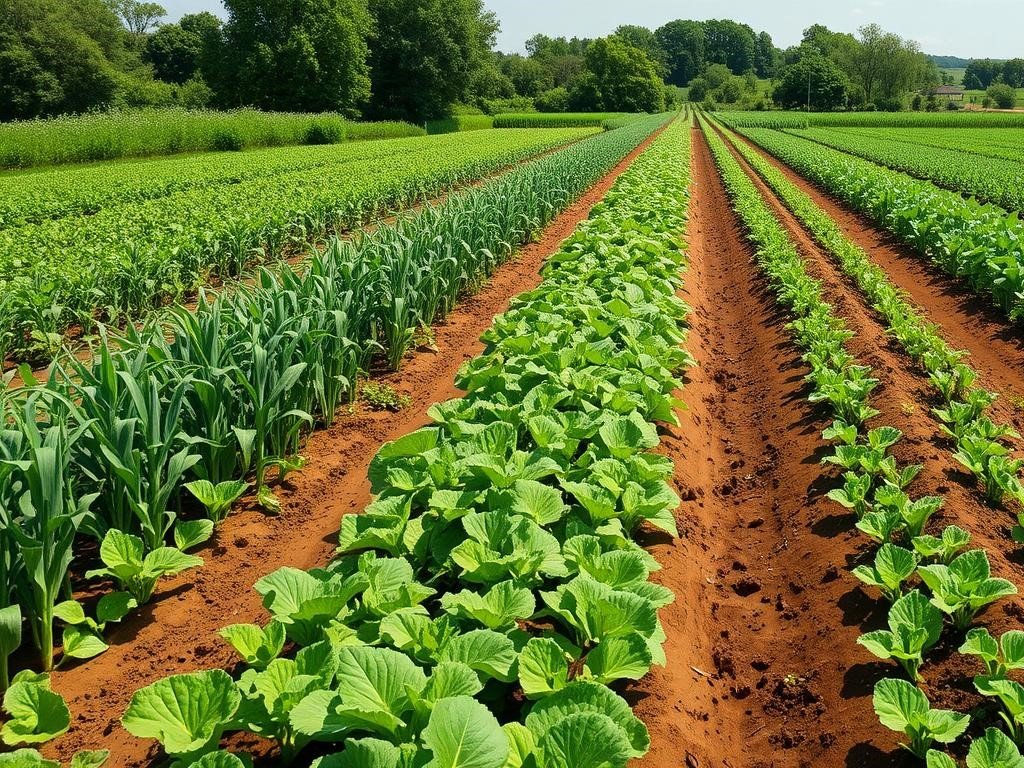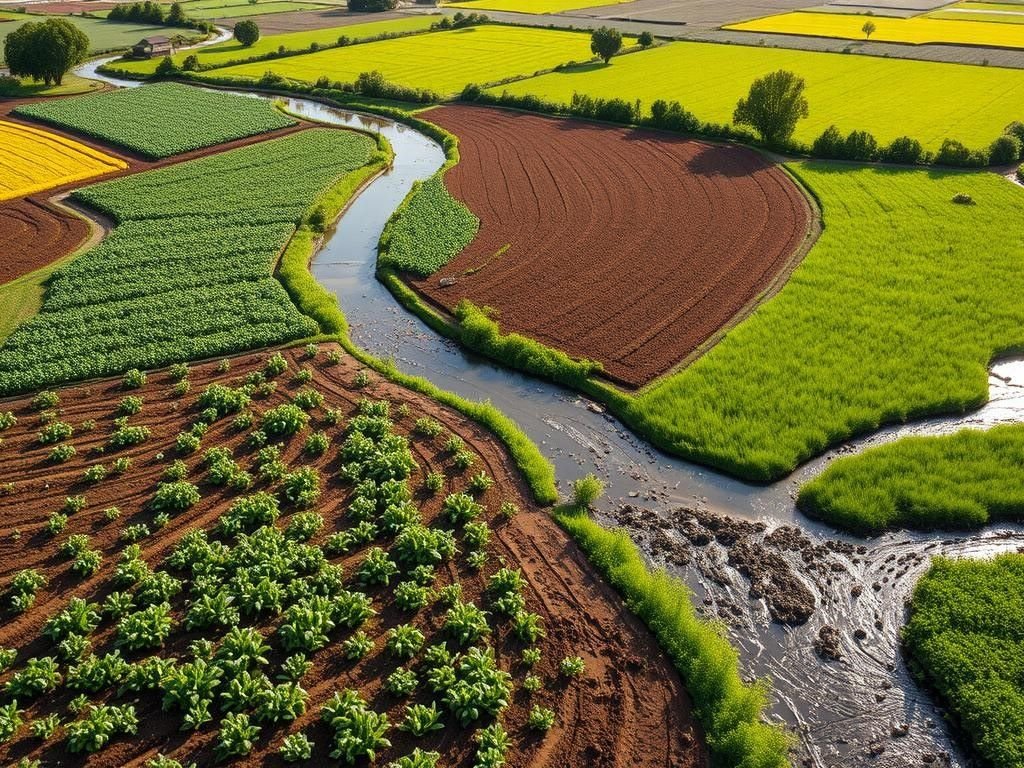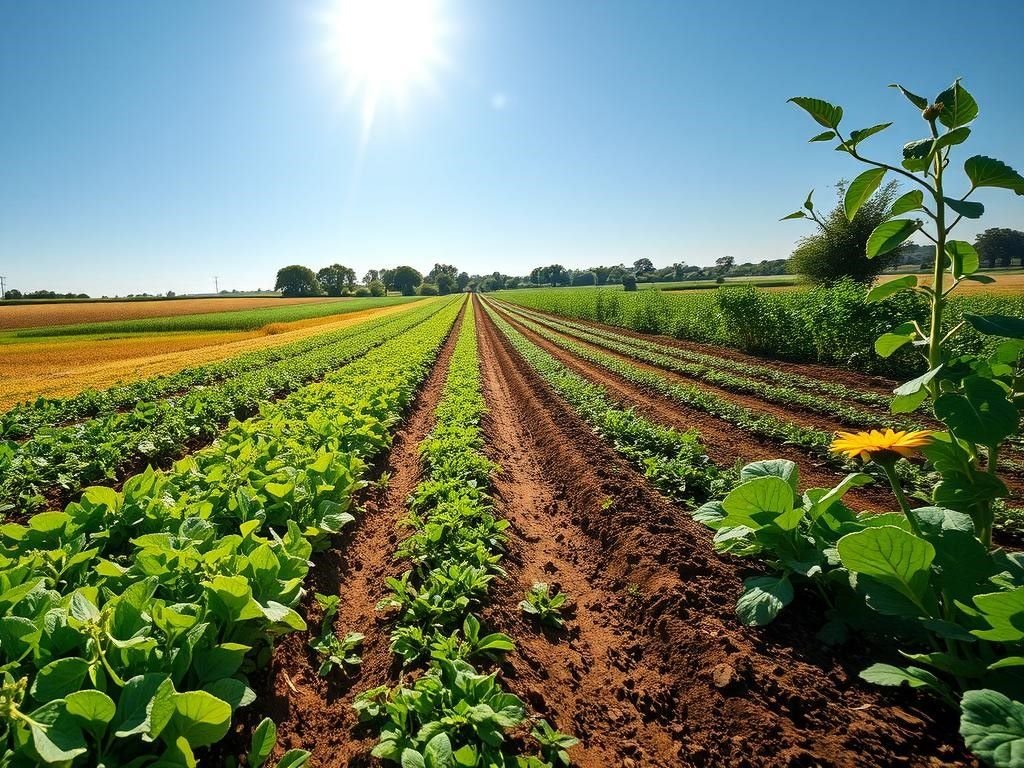Regenerative agriculture helps keep more carbon in the soil than it releases. This reduces the carbon dioxide in our atmosphere. Crop rotation is a big part of regenerative agriculture, making soil better, reducing erosion, and enhance biodiversity. This all helps to manage soil health.
Using cover crops can cut down soil erosion by up to 90%. Regenerative farming also makes farming more productive and can increase farmer earnings.

Crop rotation is the important part for keeping soil healthy in regenerative farming. It can be done with different cover crops, which helps the soil and makes farming more profitable. Using less tillage can increase soil organic matter by 20% over time. Soil health can also see a 40% increase in carbon content in some studies.
Key Takeaways
- Crop rotation is a very important component of regenerative farming, contributing to soil health management and sustainable agriculture practices.
- Implementing cover crops can reduce soil erosion by as much as 90%.
- Regenerative agriculture techniques can increase agricultural output and boost farmer earnings.
- Crop rotation helps reduce loss of soil nutrients and the need for petrochemical-based fertilizers, benefiting overall soil health.
- Soil health improvements can result in a water retention increase of up to 50%, enhancing drought resistance.
- Regenerative farming has been shown to improve water quality by decreasing pesticide runoff, contributing to a 50% reduction in water contamination levels.
Understanding the Foundations of Regenerative Agriculture
Regenerative farming is becoming more popular. It offers many benefits, like better soil health and higher crop yields. The regenerative farming benefits include more biodiversity and soil that holds water better. By using organic farming techniques, farmers can cut down on harmful chemicals. This is good for the environment and people’s health.
One important part of regenerative agriculture is crop diversity for soil health. This means growing different crops to keep the soil balanced and full of life. It makes the soil richer, reduces erosion, and makes farms more resilient. Some benefits of this approach are:
- Soil health and fertility get better
- Crops grow more and are more productive
- There’s more biodiversity and ecological balance
- Less greenhouse gas emissions and pollution
Studies show that regenerative farming can make soil healthier and more fertile. This leads to farms that produce more. It also helps soil hold water better, which fights drought and flooding.

The Science Behind Crop Rotation in Regenerative Farming
Crop rotation is key in regenerative farming, boosting soil health and fertility. It cuts down on synthetic fertilizers and balances ecosystems. Legumes like beans and peas fix nitrogen, raising yields by 10-30% for future crops.
By alternating crops over three years, farmers enhance soil health and reduce pests. This lowers pesticide use by 30-50%. Crop rotation also increases soil organic matter, improving its health by 1-2% in rotational systems.
Regenerative farming, including crop rotation, can sequester nearly 1 billion tons of carbon dioxide annually. It helps create a sustainable food system, cutting greenhouse gas emissions and conserving soil. With the global population set to hit 9.7 billion by 2050, adopting these methods is crucial for food security.

| Crop Type | Year | Benefits |
| Cereal | 1 | Improves soil structure |
| Legume | 2 | Fixes nitrogen in the soil |
| Root | 3 | Increases organic matter in the soil |
Understanding crop rotation’s science helps farmers choose sustainable practices. Companies like Nestlé and PepsiCo are embracing regenerative farming, showing its growing importance.
Essential Benefits of Strategic Crop Rotation
Strategic crop rotation is a key part of agroecology. It boosts biodiversity in farming and supports regenerative farming. By changing crops, farmers can make soil better, use less synthetic fertilizers, and keep the ecosystem balanced. Research shows that crop rotation can make soil stronger and keep it from washing away.
Crop rotation also helps manage pests and diseases. It can stop disease cycles and cut down on pesticide use. This method increases biodiversity, helping beneficial insects and natural predators. It also reduces weed growth by using different crops.
The main advantages of strategic crop rotation are:
- Soil gets better and holds more organic matter
- Less need for synthetic fertilizers and pesticides
- More biodiversity and ecological balance
- Soil erosion and flooding decrease
By using strategic crop rotation, farmers help make farming more sustainable. This follows agroecology principles and boosts biodiversity. It also lowers farming’s environmental impact, making the ecosystem and food system healthier.
Implementing Effective Rotation Patterns
Effective crop rotation in regenerative farming is key for keeping soil health management strong. It helps in using sustainable agriculture practices. By planning a good rotation, farmers can lessen soil loss and cut down on pesticides and fertilizers. This also boosts biodiversity.
It makes the soil better and more fertile. Plus, it helps farms stay strong even when growing conditions are tough.
When setting up rotation patterns, it’s important to think about the soil, climate, and what crops to use. This helps farmers make a mix that’s good for the soil and less likely to erode. Adding livestock to the farm can also make the soil richer and healthier.
Some good things about using effective rotation patterns include:
- Less soil loss and erosion
- Better soil quality and fertility
- Stronger farms against bad growing conditions
- Less need for pesticides and fertilizers
By using sustainable agriculture practices and good rotation patterns, farmers help the soil and the food system. This way, they can also make more money and spend less on inputs.
Soil Microbials Enhancement Through Rotation
Regenerative farming benefits from crop rotation, which boosts soil health and supports good microbes. It’s key to have diverse crops to create a balanced ecosystem. This reduces the need for harmful chemicals. Organic farming, like using last year’s crop residue, increases soil’s organic matter. This makes nutrients more available for microbes.
Soil microbiome enhancement brings many benefits, including:
- Soil structure and water retention get better
- Nutrient cycling and availability increase
- Plant growth and resilience improve
These advantages come from smart crop rotation and organic farming methods like cover cropping and manure use. Research also shows certain microbes play a big role at different growth stages. They affect plant health and nutrient availability.
By using regenerative farming, farmers can boost soil microbiome. This leads to better crop yields and less environmental harm. It also helps create more sustainable and resilient farming systems. This supports the long-term health of our planet.
| Practices | Benefits |
| Cover Cropping | Reduces greenhouse gas emissions, improves soil health |
| Companion Planting | Increases biodiversity, improves crop yields |
| No-Till Agriculture | Reduces soil erosion, improves soil fertility |
Overcoming The Common Challenges of Rotation Planning
Effective crop rotation is key in regenerative farming. It helps keep soil healthy and supports sustainable farming. But, planning and implementing rotations can face several challenges. Climate, like temperature and rain, must match the crops chosen. Also, making sure the rotated crops meet market demand is crucial for profit.
Managing resources well is also important. This means using the right amount of labor, equipment, and inputs for each crop. Using cover crops and legumes can improve soil and cut down on synthetic fertilizers. The demand for sustainable farming is growing, showing the need for better soil management.
To tackle these issues, farmers can mix up their crops. This improves soil and boosts biodiversity. It also cuts down on chemical use and builds stronger ecosystems. By planning well, farmers can face these challenges head-on. This leads to better farming and healthier soil.
Trends of Regenerative Agriculture in Future
The world faces big challenges like climate change, soil damage, and water issues. But, regenerative farming is gaining importance. It focuses on using crop diversity and organic methods to improve soil health. Over 20% of General Mills’ North American sources now use regenerative practices.
The company wants to cover 1 million acres with regenerative farming by 2030.
Regenerative farming can cut down on the need for chemicals and boost crop yields. It also helps keep soil healthy. Cover crops and less tilling are key to this, keeping carbon in the soil.
More farmers are using digital tools and precision agriculture. In North America, 61% of farmers are now using these technologies.
Some major trends in regenerative agriculture include:
- More farmers and companies adopting regenerative practices
- Advancements in technology, like drones and precision farming
- Better ecosystem services, like soil health and biodiversity
As people want more sustainable food, we’ll see more investment in regenerative farming. New technologies and practices will support these trends. Regenerative agriculture is key to fighting climate change, improving soil, and boosting crop yields.
Conclusion: Embracing Crop Rotation for Agricultural Sustainability
Crop rotation is a key to a sustainable future in farming. It improves soil health and reduces the need for harmful chemicals. This method helps achieve ecological balance and resilience.
Strategic crop rotation offers many benefits. Farmers see better soil, manage pests and diseases well, and keep more water. This leads to higher yields and profits. Also, diverse crops and cover crops boost biodiversity and support ecosystems.
Looking ahead, regenerative agriculture with crop rotation is crucial. It tackles climate change, food security, and environmental issues. These practices reduce waste, improve soil, and promote biodiversity, leading to a better agricultural future.
It’s time for everyone – farmers, policymakers, and consumers – to support crop rotation and regenerative farming. Together, we can create a future with healthy soils, thriving ecosystems, and plenty of food.
FAQ
What are the key principles of regenerative farming?
Regenerative farming focuses on ecological balance and biodiversity. It also highlights the importance of healthy soil. This is the foundation for a strong agricultural system.
How does crop rotation benefit soil health in regenerative farming?
Crop rotation improves soil structure and nutrient cycling. It also boosts the diversity of beneficial microbes. These factors lead to better soil fertility and ecosystem services.
What are the different types of crop rotation in regenerative agriculture?
Regenerative farming uses various crops like legumes, cereals, and others. Each crop has unique benefits for soil health and ecosystem balance.
How does crop rotation help with pest and disease management in regenerative farming?
Crop rotation disrupts disease cycles and pest habitats. This reduces pesticide use, making the agroecosystem more balanced and resilient.
What are the key considerations in implementing effective crop rotation patterns?
Effective crop rotation needs careful planning. Consider soil type, climate, and crop selection. Ongoing monitoring and adaptation are also crucial.
How does crop rotation impact the soil microbiome in regenerative agriculture?
Crop rotation boosts beneficial microbes. These microbes are key for decomposing organic matter and fixing nitrogen. They improve soil health and ecosystem services.
What are the economic advantages of adopting regenerative crop rotation practices?
Regenerative crop rotation saves costs through reduced tillage and pesticide use. It also improves soil fertility and can increase yields. This leads to higher profits for farmers.
How can crop rotation be integrated with other sustainable farming practices in regenerative agriculture?
Crop rotation works well with cover cropping, companion planting, and no-till agriculture. These practices enhance soil health, biodiversity, and ecosystem services.
What are some common challenges in implementing crop rotation in regenerative farming, and how can they be overcome?
Challenges include climate factors, market demand, and resource management. Careful planning, adaptation, and integration with other practices can help overcome these challenges.
What are the future trends and opportunities in regenerative agriculture?
Regenerative agriculture’s future looks promising. Increased adoption is expected due to policy, education, and market demand. Advanced technologies like precision agriculture will enhance sustainability and resilience.